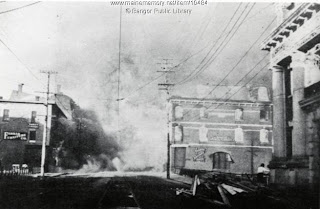If anyone ever had a reason to say, “I told you so” it was the woman in Bangor, Maine who, in April of 1911, wrote a poem warning the city of Bangor that their indecision over building a new library, not made of wood, was putting the collection of 70,000 books at risk.
Thanks to Ryan R. Robbins’ detailed history in Bangor in Focus we can feel her pain and frustration...
We oft have dreamed of a library fair
That with other cities would well compare,
But our dreams alas! are but castles in air.
And our Bangor library is where -- Oh! Where?
Fair spring is come, 'twill soon be May,
The workingmen -- they need the pay --
The public wait from day to day
Still the trustees dally and delay.
And yet we wait tho' a year's gone by
And Bangoreans still for their library sigh.
Oh! Will the time then ne'er draw nigh?
And the question asked is, "Why, oh, why?"
Why should our books be allowed to burn?
Why should the trustees our wishes spurn?
The answer, alas! We have yet to learn
But the frailest worm will sometimes turn
Let the people then rally and no longer wait
Let them honor themselves and the Pine Tree state
With a building that's fair both for lowly and great
A blessing to all, free from discord and hate
Can you imagine finding such eloquence in a letter to the editor in your morning paper?
Thanks to Ryan R. Robbins’ detailed history in Bangor in Focus we can feel her pain and frustration...
We oft have dreamed of a library fair
That with other cities would well compare,
But our dreams alas! are but castles in air.
And our Bangor library is where -- Oh! Where?
Fair spring is come, 'twill soon be May,
The workingmen -- they need the pay --
The public wait from day to day
Still the trustees dally and delay.
And yet we wait tho' a year's gone by
And Bangoreans still for their library sigh.
Oh! Will the time then ne'er draw nigh?
And the question asked is, "Why, oh, why?"
Why should our books be allowed to burn?
Why should the trustees our wishes spurn?
The answer, alas! We have yet to learn
But the frailest worm will sometimes turn
Let the people then rally and no longer wait
Let them honor themselves and the Pine Tree state
With a building that's fair both for lowly and great
A blessing to all, free from discord and hate
- April 13, 1911
Can you imagine finding such eloquence in a letter to the editor in your morning paper?
 |
| A photo of the fire from the Maine Memory Network |
Three weeks later, on April 20, 1911, the library was engulfed in flames. Only 29 volumes were rescued. The entire collection was reduced to ashes, a complete and absolute loss. My guess is that the poem’s author took no satisfaction in her accurate prediction or the loss of $300,000 worth of books.
The crushing blow might have discouraged other cities but in Bangor they packed up their one box of books, picked up 49 that were out getting bound and three weeks later were doing business in the basement of the Penobscot Court House. The Portland Library, Maine State Library, Bowdoin College Library and a library in Medford, MA generously sent books to begin the collection once again.
By January they already had 7,000 books (1,000 books had been checked out at the time of the fire). Not surprisingly, the trustees decided to stop procrastinating and hired Peabody and Stearns to design a new brick and stone building.
Perhaps guilt was responsible for the decision to make the new library an “architectural showcase”. Ryan Robbins describes the space that opened to the public on December 20, 1913 as “a copper-framed dome and rotunda, glass ceilings and floors for the second floor, and large fireplaces on the first floor. The trustees also voted to inscribe the names of 12 distinguished, New England-born writers on the rotunda: Aldrich, Ralph Waldo Emerson, Fiske, Nathaniel Hawthorne, Oliver Wendell Holmes, Henry Longfellow, Lowell, Palfrey, Parkman, Prescott, Whittier and Bryant.”
Perhaps guilt was responsible for the decision to make the new library an “architectural showcase”. Ryan Robbins describes the space that opened to the public on December 20, 1913 as “a copper-framed dome and rotunda, glass ceilings and floors for the second floor, and large fireplaces on the first floor. The trustees also voted to inscribe the names of 12 distinguished, New England-born writers on the rotunda: Aldrich, Ralph Waldo Emerson, Fiske, Nathaniel Hawthorne, Oliver Wendell Holmes, Henry Longfellow, Lowell, Palfrey, Parkman, Prescott, Whittier and Bryant.”
Librarians used the occasion to update their catalogue system to the new Dewey Decimal card catalog. By 1920 the collection had returned to pre-fire size and six years later, at 120,000 volumes it would be the largest in the state of Maine.
The library was at full capacity by 1927 but there was no money to expand, it wasn’t until 1959 that a 30’ x 100’ addition relieved some of the pressure. But that didn’t last long, as the library continued to grow the stacks became unsafe for patrons to walk through and librarians had to fill requests on demand. It was clear that something had to be done about the library, but who would do it?
None other than the most famous resident of Maine (and I don’t mean Andre the Seal)








